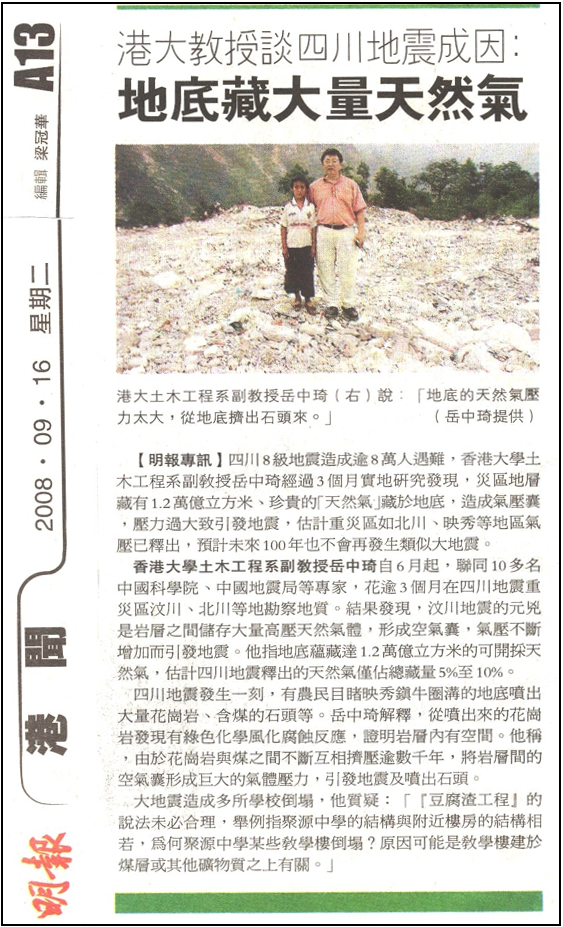博文
2008年以来气体制震研究的小结
|
2008年以来气体制震研究的小结
岳中琦
在2008年9月16日,香港四份报纸报道了,我关于汶川大地震是地下深部岩体中大量极高压甲烷气体释放造成的科研发现和成果。

这报道引发了,不少关心地震研究、地震预报和工程抗震的科技人员的疑问和质疑。同时,它也引发了,不少关切地球油气能源资源是否会枯竭的各类人士的疑问和质疑:
地球内部真会有这么多的甲烷气吗?
因此,我非常感谢他们的关心和问题。他们提出的问题也绝非是一两句话能够解答清楚的。我一直在深入研究。
现在,我可以给出一个气体制造地震研究的小结了。它记录在我以下发表的相关论文之中。它可以给出他们问题的初步回答了。
Yue, ZQ, 2010.Features and mechanism of coseismic surface ruptures by Wenchuan Earthquake, in Rock Stress and Earthquake, edited by Furen Xie, Taylor & Francis Group, London, ISBN 9780415601658, pp.761-768
岳中琦,2011.论地震和天然气的一个共同成因,《地学哲学通讯》,2011年第1期,总第50期,21-64
岳中琦,2011.与香港地区地震危险性相关的汶川地震灾害调查的五点认识,《华南地震》,第31卷,第2期,14-20
Yue, ZQ, 2013. Natural gas eruption mechanism for earthquake landslides: illustrated with comparison between Donghekou and Papandayan Rockslide-debris flows, in Earthquake-induced Landslides,K. Ugai et al. (eds.), Springer-Verlage Berlin, ISBN 9780784412992,Chapter 51: pp. 485-494
Yue ZQ, 2013. On incorrectness in elastic rebound theory for cause of earthquakes, Proceedings, 13th International Conference on Fracture, June 16-21, 2013, Beijing, Paper No.S20-003 of Session S20, pp: 1-10.
Yue ZQ, 2013. On nature of earthquakes with cause of compressed methane gas expansion and migration in crustal rocks, in Proceedings of Fifth Biot Conference on Poromechanics in Memory of Karlvon Terzaghi (1883-1963), July 10-12, 2013, Vienna, Austria, edited by Christian Hellmich, Bernhard Pichler and Dietmar Adam, ÓASCE, ISBN/ISSN:9780784412992,pp. 507-516.
Yue ZQ, 2013. Why our Earth’s crust not quiet? Global View of Engineering Geology and the Environment – Wu & Qi (eds) © 2013 Taylor & Francis Group, London,ISBN 9781138000780, 43-50
岳中琦,2013. 汶川地震与山崩地裂的极高压甲烷天然气成因和机理,《地学前缘》,20(6):15-20;DOI: ISSN: 1005-2321 CN: 11-3370/P
ZQ Yue, 2014.On cause hypotheses of earthquakes with external tectonic plate and/or internal dense gas loadings, Acta Mechnica, 225,1447–1469 (2014), DOI 10.1007/s00707-013-1072-2.
2014年,在Acta Mechanica发表的论文摘要如下:
This paper examines and compares the two loading systems and their associated energy and basic stress fields in elastic crustal rock mass for the cause of tectonic earthquakes. The first loading system is an external loading system and associated with the conventional earthquake cause hypothesis of active fault elastic rebounding. The second is a combined loading system where the first external loading system is added with a dense gas loading in the interior of deep crustal rock faults/defects. It is associated with the methane gas hypothesis for the cause of tectonic earthquakes.
Five elastic stresses in rock solids with some idealized faults and caverns are presented to illustrate the similarities and differences of the stress fields and the possible rupture failure modes in association of the two loading systems. The theoretical results can show that any changes in the local stress concentrations due the external loading alone can be reflected and noticed in the corresponding stresses at the far field. On the other hand, any changes in the local stress concentrations due to the internal gas loading cannot be observed and distinguished in the tectonic stress field at the far distance.
These theoretical results can beused to well explain the consensus of earthquake unpredictability with present technology. The theoretical results can further show that the external tectonicloading alone can only cause shear ruptures in crustal fault rocks with high compressive stresses, and such shear rupture or frictional failure is also difficult to occur because its shear plane has extremely high compressive normal stress. The combined loading can cause not only shear ruptures, but also tensile ruptures in crustal fault rocks, and such shear and tensile ruptures occur much easier since the rupture plane can have very low compressive or even high-tensile normal stress.
It is argued that the earthquake energy is the volumetric expansion energy of dense gas mass escaped from the deep traps along crustal rock faults. The migration and expansion of the escaped dense gas mass in the crustal rock faults and defects cause the seismic body waves, the ground sounding, the seismic surface waves, the ground co-seismic ruptures and damages. Its rapid migration and expansion in thick water cause tsunamis in lakes and oceans. Its rapid migration and expansion in the atmosphere cause the sky to become cloudy.
The dense methane gas is produced every day in the mantle and core of the Earth, migrates outward and accumulates and stores beneath the lower crustal rock in high compression. It forms a thin spherical layer of dense methane gas separating the cold crustal rocks and the hot mantle materials. Its leaking along deep faults or plate boundaries causes earthquakes and supplies to shallow gas and oil reservoirs beneath secondary traps in adjacent basins of the upper crustal rock mass.
特别地,计算出存在于地壳和地幔之间薄层甲烷气圈层所夹高压强、高密度甲烷气体的质量是大气圈气体质量的10到240倍。这个气圈甲烷气会不断增多,且以数十年为周期的大地震形式,在深大断裂与造山带,向上地壳、海洋和大气圈排放。
2014年4月13日21:57写成于香港大学黄克競楼办公室
2016年11月10日19:00修改于香港大学黄克競楼办公室
https://blog.sciencenet.cn/blog-240687-784615.html
上一篇:梁启超先生1920年四步发展设想和现代SCI论文发表
下一篇:读嵇少丞教授的“四川盆地内部一天四震说明什么?”有感